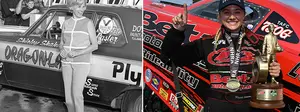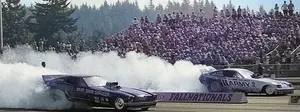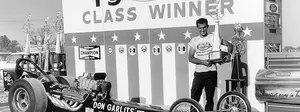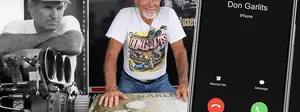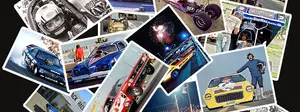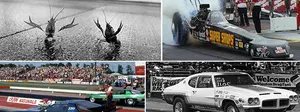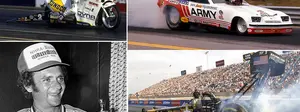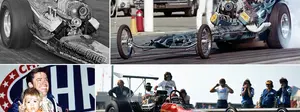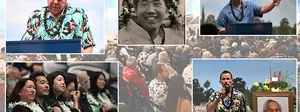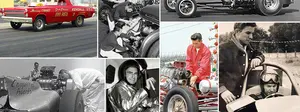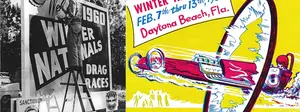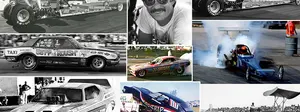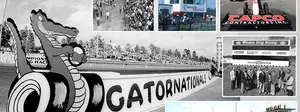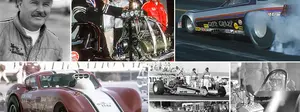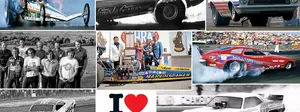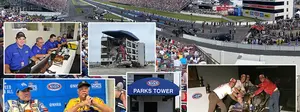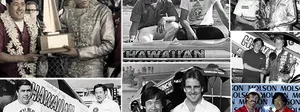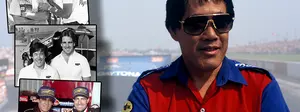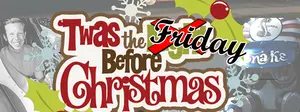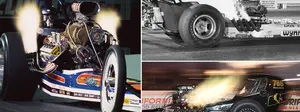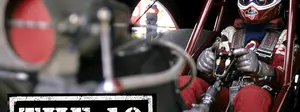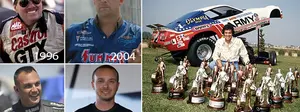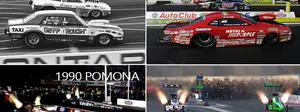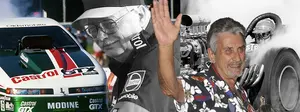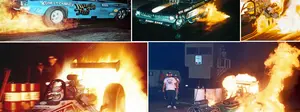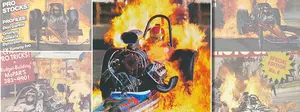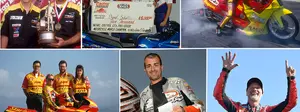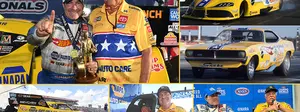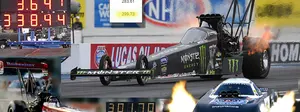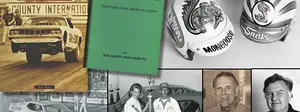Peebles, Woodall, and a golden era
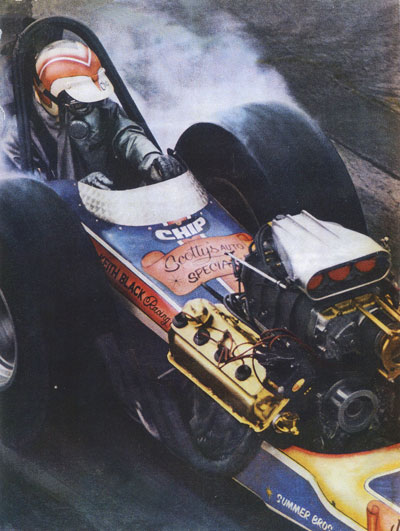 From his first slingshots to the final rear-engine car (bottom), Jackie Peebles' dragsters were adorned with 24-karat gold plating. |
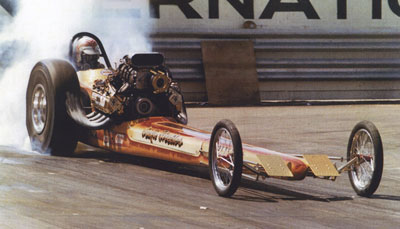 |
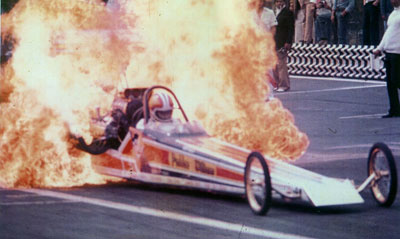 Fire burnout, Mexico City, 1978 |
When it comes to gold-plated Top Fuel cars, Chris Karamesines may have gotten all of the headlines after he crashed his beautiful rail at the 1975 Gatornationals, and the Ruffalo & Ehlen team may have set the record for expenditure with its gold-bedecked beauty later that decade, but credit for the concept goes back many more years, to Texas car owner Jackie Peebles and a series of 24-karat killers that he campaigned from the late 1960s through the late 1970s.
It took only a brief mention of me trying to track down Peebles and his longtime driver Chip Woodall in a recent column to make contact with both, as the Texas grapevine is still plenty active, and I spoke with both of them last week. Woodall was kind enough to ship me a bunch of the photos that you’ll see in today’s column.
Although Woodall is best known to casual fans as the driver of Gene Snow’s Top Fueler, in which he won the 1972 NHRA Springnationals and set the national e.t. record, he spent considerably more time in Peebles’ cars, all of which were gold-plated.
I had never met either, as they left the sport before I joined NHRA in 1982, but Woodall’s reputation as another of those larger-than-life Texas characters was well-cemented and tales of his exploits passed down to the staff like old family stories. It was a time when between-race carousing was not only accepted but damned near expected. “We were kind of like renegades,” Woodall said in a 1994 National DRAGSTER interview. “We raced hard and, at times, played hard.”
Woodall began his dragster career in his teens, first in gas dragsters, then Jr. Fuel before graduating to a good-running Chevy-powered A/Fueler with Ted Tholcken in 1966, and then into a couple of Top Fuel rides before beginning a long career with Peebles in 1969. (Intriguing side note: When Woodall joined Snow’s team, he was touted as being 21 years old, even though he was 26. Numerous stories in DRAGSTER allude to him being famously elusive about his age, adding “an aura of mystery.” Today, there is no mystery. His birthdate -- June 21, 1945 -- is clearly posted on his Facebook page.)
According to Woodall, when he first met Peebles, he and partner Dickie Williams were campaigning the ex-Hawaiian dragster previously driven for Roland Leong by Mike Snively in 1968 and had gone through several drivers, including Texan Gary Bailey and West Coast hot shoe Stan Shiroma. Although he couldn’t recall the circumstances of their meeting during our interview, one of the old Fort Worth Star-Telegram newspaper clippings Woodall sent explained how they had met at the Springnationals the year before, where Woodall had crashed.
“[Jackie] had been having trouble with his drivers, so I told him that if I didn’t hit the 6.60s and 230s during the first three runs, he could drop me,” Woodall was quoted as saying. During his first run in the car, he set the Louisiana state record of 6.62 at 231 mph, and the rest is part of a long history.
“Chip was like one of my own kids,” said Peebles. “He was a kid [23] when he started driving for me.”
All of Peebles’ cars were exquisitely plated, thanks to Peebles' ownership of a chain of plating shops and the then low cost of gold.
The entire front end -- wheels, radius rods, axles, and spoiler – was covered in the precious metal as were the rear wing, valve covers, water necks, steering wheel, brake handle, Dzus fasteners, and most everything on the front part of the motor. Peebles didn’t stop there, adding decorative “engine turns” to much of the plating, and all of the aluminum was gold-anodized.
“With those engine turns, the gold has a jeweled finish, and when it got into the sun, it was hard to look at,” he said with a laugh. “It wasn’t as expensive as it is now to do that gold-plating, but nobody else was doing it before us.”
The duo was runner-up to Don Garlits at the 1969 AHRA World Championships race at Green Valley Race City and boasted a 95 percent win ratio in match racing that year and was a perennial low qualifier. The car won Most Outstanding Car honors at the 1970 Dallas Autorama and, more important, the Division 4 championship.
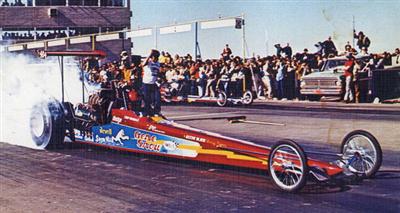 The two parted company briefly in 1972, when Woodall was offered the seat in Snow’s new Revell-sponsored dragster. Snow had been campaigning just a pair of Dodge Charger Funny Cars – with him and Jake Johnston behind the butterfly – but added the Woody Gilmore-built dragster as well as an injected Funny Car, wheeled by Terry Pringle, that year.
The two parted company briefly in 1972, when Woodall was offered the seat in Snow’s new Revell-sponsored dragster. Snow had been campaigning just a pair of Dodge Charger Funny Cars – with him and Jake Johnston behind the butterfly – but added the Woody Gilmore-built dragster as well as an injected Funny Car, wheeled by Terry Pringle, that year.“It was a good opportunity for me, moneywise, so I had to take it,” said Woodall. “Jackie understood and never got mad, and we remained the best of friends.”
Woodall’s employ with Snow was short-lived but spectacular.
After the national record was reset to a 6.30 minimum following a rule change regarding excessively staggered front wheels, Woodall quickly reset the national e.t. record to 6.27 at New England Dragway in May – he actually ran quicker, 6.20, but was unable to back it up for the record – but it wasn’t cheap.
“We tore up a lot of things, but the car ran good,” said Woodall, who was tuning the car. “Back then, we didn’t have big teams, so most us [tuned] our own stuff. It took us three motors to get the record. I called Snow Saturday night and told him I’d blown up two motors trying to get the record and probably was going to blow up another to get it done. I think that kind of pissed him off.”
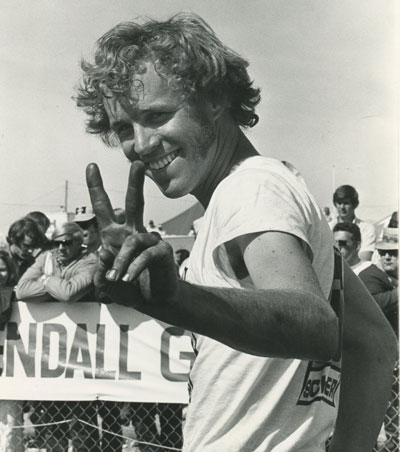 Chip Woodall flashed the "V for victory" sign to ND Photo Editor Leslie Lovett after beating Carl Olson on a holeshot in the final at the 1972 Springnationals. |
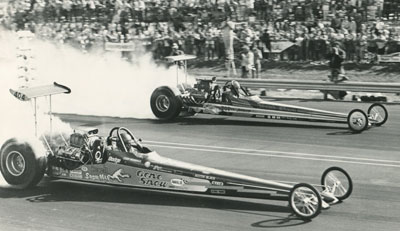 |
On the match race trail, Woodall reportedly set track records at 21 of the 27 strips they visited, and won the 1972 NHRA Springnationals at its new home, National Trail Raceway, in impressive fashion. After qualifying No. 1 with a 6.39 in Columbus, he ran 6.42, 6.46, and 6.45 to defeat Randy Allison, Dale Funk, and Herm Petersen despite nursing a cracked rear end, then defeated Winternationals champion Carl Olson – who was fresh off a pair of back-to-back 6.42s – in the final on a holeshot, 6.81 to 6.73.
(Olson painfully remembers it well. "Columbus had a habit of getting very slick toward the end of the day. We had marched right through the field without any traction problems. Prior to the final, 'Kansas John' Wiebe, a fellow Donovan 417 pioneer, came over to our camp and convinced [Mike] Kuhl that in order to beat Woodall, we'd have to hop up the engine as he knew that Gene Snow was going to 'power up.' I objected fearing tire smoke but got outvoted. Kuhl succumbed to temptation and 'turned the screw.' In order to avoid smoking the tires, I tried to ease the car off the starting line. In doing so, I was late on the light. As fate would have it, both cars smoked the tires heavily in spite of my attempts to avoid doing so. I recovered first, so got the better e.t., but he got to the finish line first. Worst loss of my career. Two lessons learned: Don't listen to advice from others, regardless of how well-intended, and don't alter your driving style to compensate for deteriorating track conditions. One bad for Kuhl, one bad for me. Neither of us ever made those mistakes again.")
Woodall's joy was not long-lived, as disaster struck shortly after that high point in Columbus. On the road from Texas to the NHRA Summernationals in Englishtown, the young crewmember driving the rig fell asleep outside of Hope, Ark., and the truck went off the road and rolled. The almost fully loaded 200-gallon fuel tank caught fire, and Woodall, the crewmember, and respected journalist Woody Hatten – along for the ride to document the trip – escaped with their lives but not without injury as a 55-gallon barrel of nitro crushed Woodall’s shoulder and broke some ribs. The truck was melted and the trailer badly damaged (the race car less so), which put an end to the effort. “Snow never really wanted the dragster – he hated them – and he only built it because Revell wanted one,” said Woodall.
 Woodall's Funny Car years with Peebles & Williams were wild, too. (Above) They burned this Barracuda body to the ground in Tulsa, Okla., and (below) lost this one while beating Butch Maas in the final round of an AHRA event. |
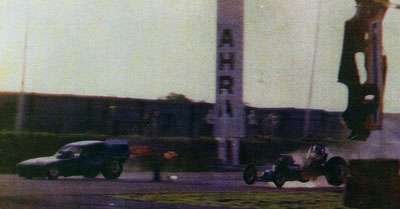 |
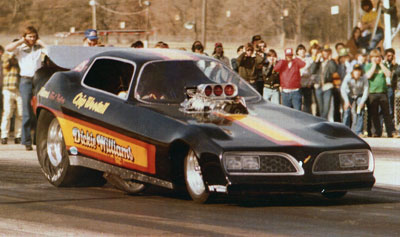 Woodall's last Funny Car ride was this Trans Am, owned by Dickie Williams. |
Peebles – whose car had continued to enjoy success, first with Bob Gibson, who was low qualifier at the 1971 World Finals, and later Larry LaDue at the wheel -- drove up to rescue Woodall from the hospital, and before long, they were back together, and Williams rejoined the team that soon began to field a Funny Car as well.
Woodall’s Funny Car days were no less explosive, capped by a huge fireball at a Tulsa (Okla.) PDA race in an incident that shows what a rough-and-tumble time the 1970s were and the breed of character that drove the cars back then.
“We had run in Chicago the night before and burned a piston, but we didn’t have time to change it,” remembered Woodall. “We drove all night and only had a few minutes to qualify. I knew it had a burned piston in it, so I tried to block the cylinder off because I knew it would still qualify. I’d also used up the fire bottles in Chicago, and we didn’t have time to refill them." The car caught fire and burned the body off, but Woodall was not injured.
“Drivers today don’t have any idea what we had to go through back then,” he lamented. “It was a different time, but a helluva lot of fun, too.”
Eventually, as Peebles’ business grew, he had less time for racing, and by 1978, both he and Woodall were essentially out of the sport.
“My chrome-bumper business [Bumper Services] got thick and heavy, and I had plants in Houston; Fort Worth, Texas; Mobile, Ala.; Newark, N.J.; Wichita, Kan.; and Tulsa, Okla.,” remembered Peebles, who has been in the business for more than 50 years, beginning at age 16. “They ran my butt to death. I was either on the highway or in the air to one of those places, always on the move like when I was racing.”
Today, Peebles owns only one shop, North Texas Quality Chrome in Gainesville, Texas, where one of his partners is his son Carey. Their work has even graced presidential aircraft.
Woodall drove every now and then – including a memorable trip to England in 1980 – but before long, he, too, had hung up his driving gloves. He later became partners with the late Sam Harris in Chaparral Trailers and was in the wholesale car business for a dozen years before retiring.
Peebles and Woodall have remained good friends despite Woodall’s best efforts otherwise.
“Jackie invited me to his wedding but told me I had to behave myself," recalls Woodall. "I thought, ‘Well, that’s kind of rude,' so I called up Joe, an attorney who is one of our mutual friends, and we went to a professional costume shop. I got a Kermit the Frog suit, and Joe got a gorilla suit. We rented a limousine and told him to drive us to the church but to wait outside ‘in case something happens.’ My costume had this big ol’ helmet where you look out through the mouth – I’m 6-foot-2, so this thing must have been 6 and a half feet tall – and green leotards, and Joe’s gorilla suit absolutely made him look like a real gorilla. We wandered in there about halfway down the aisle and sat down, and the old preacher got plenty mad, yelling about how this was a house of God and not some zoo act. We were laughing so hard I thought we were going to die. We ran back out to the limousine and escaped. We changed clothes and went to the reception. Jackie started yelling at us, and we told him it wasn’t us, that Joe had just picked me up at the airport. He said, ‘No one walks like you. I know it was you.’ For years, his wife wouldn’t talk to me. She wasn’t real proud of us. A few years later, I was in Las Vegas and saw a greeting card with Kermit the Frog on it and sent it to her.”
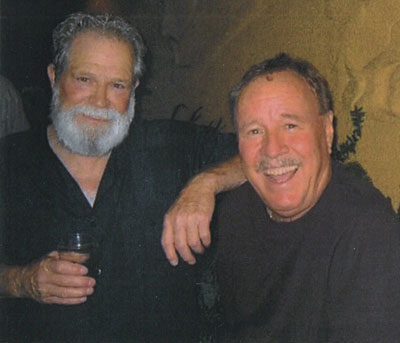 Two of Texas' wildest nitro pilots today: Jim Nicoll, left, and Woodall. |
Woodall’s zany antics – which included chomping down on a raw fish at Jim Annin’s annual post-season party and another time swallowing a live bug, both on bets the proud Texan just couldn’t pass up – extended to the racetrack as well. Chief Starter Buster Couch, who was famously afraid of no man and nothing, except snakes, was one victim.
“It was at Amarillo [Texas] one year during the World Finals, and I stuffed a big ol’ rubber snake down between my legs in the cockpit,” he reminisced. “After I backed up from the burnout, I motioned Buster over to the car and tossed it out to him. Later in the race, I did the same thing but that time handed him a bottle of Boone’s Farm wine. [Competition Director Steve] Gibbs really got on my ass about that one. ‘How do you think that would look on TV?’ he asked. I told him, ‘[Shoot], I don’t care.’ He was plenty mad; he still gets on me about that.
“Man, we had some fun.”
Thanks to Chip and Jackie for reminiscing with me and sharing their great memories. In the note he enclosed with his photos, Woodall wrote, "Thanks a million for thinking about us old bastards."
My pleasure, for sure.

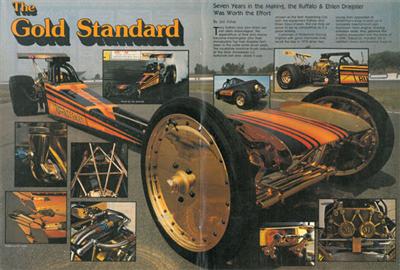 Backtracking a bit, several people pointed me toward a copy of the March 1980 edition of Car Craft for an in-depth article on the Ruffalo & Ehlen gold-plated Top Fueler. Tony Ruffalo himself later sent me a digital copy of the article, from which I extracted the detail photos at right. You can see just how pretty the car was.
Backtracking a bit, several people pointed me toward a copy of the March 1980 edition of Car Craft for an in-depth article on the Ruffalo & Ehlen gold-plated Top Fueler. Tony Ruffalo himself later sent me a digital copy of the article, from which I extracted the detail photos at right. You can see just how pretty the car was.
Midwest drag racing history expert Bret Kepner noted his surprise that I had neglected to mention that the car won the Best Appearing Car award at the Silver Anniversary U.S. Nationals in 1979; Ruffalo had told him that year that the car was specifically designed to earn that very honor.
Kepner also corrected Ruffalo’s memory of the track record that the team broke in St. Louis, noting that the 244-mph pass he made at a UDRA show there in 1981 actually broke Jerry Ruth’s track mark, not Don Garlits’.


